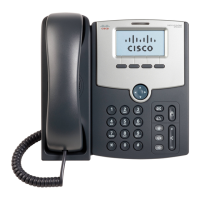Configuring SIP, SPCP, and NAT
Network Address Translation (NAT) and Cisco IP Phones
Cisco SPA 500 Series and WIP310 IP Phone Administration Guide 104
4
STEP 1 Click Admin Login and advanced.
STEP 2 Click the SIP tab.
STEP 3 Under NAT Support Parameters, configure the following:
• Handle VIA received, Insert VIA received, Substitute VIA Addr: yes
• Handle VIA rport, Insert VIA rport, Send Resp To Src Port: yes
• EXT IP: Enter the public IP address for your router.
STEP 4 Click the Ext <number> tab. Configure the following:
• NAT Mapping Enable: Choose yes.
• NAT Keep Alive Enable: Choose yes (optional).
STEP 5 Click Submit All Changes.
NOTE You also need to configure the firewall settings on your router to allow SIP
traffic. See “Configuring SIP,” on page 81.
Configuring NAT Mapping with STUN
If the ITSP network does not provide a Session Border Controller functionality, and
if other requirements are met, it is possible to use STUN as a mechanism to
discover the NAT mapping. This option is considered a practice of last resort and
should be used only if the other methods are unavailable.
Requirements
• STUN is a viable option only if your router uses asymmetric NAT. See
“Determining Whether the Router Uses Symmetric or Asymmetric NAT,” on
page 106.
• You must have a computer running STUN server software. You can use a public
STUN server or set up your own STUN server.

